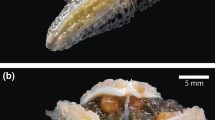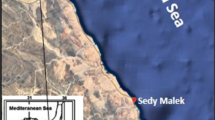Abstract
Reproductive systems of rare adult specimens of the deep-sea squid genera Chiroteuthis, Mastigoteuthis, Liocranchia, and Bathoteuthis were collected in 2006 and 2015 in the different research surveys in the Atlantic Ocean between 46°40′S and 17°11′N. Whole squids were preserved in 4% buffered formaldehyde solution, subsequently transferred into 70% ethanol and studied in laboratory condition providing initial observations on spawning pattern in these animals. The potential fecundity of Ch. cf. joubini was ~ 45,000–50,000, the maximum egg size was 1.6–1.7 mm, while those of M. agassizii were ~ 8000–16,000 and 1.7–1.9 mm respectively. A maturing female of B. skolops had ~ 4800 eggs of which some ~ 1200 were atretic. The ovary of a spent L. reinhardti contained ~ 116,500 post-ovulatory follicles and no residual egg. Mature females of Chiroteuthis and Mastigoteuthis had spematangia implanted externally in the mantle, whereas Liocranchia had a specialised spermatangia receptacle on the inside of the mantle. Reproductive adaptations of these genera are discussed in relation to spawning habits of other deep-sea squids. Synchronous ovulation was found to be a prevailing type of the gonad development with all eggs being spawned as a single batch, with ot without brooding. In some species, this single batch is not released at once but in several consequent portions exhibiting ‘extended synchronous’ spawning.





Similar content being viewed by others
References
Arkhipkin AI, Bizikov VA, Fuchs D (2012) Vestigial phragmocone in the gladius points to a deepwater origin of squid (Mollusca: Cephalopoda). Deep Sea Res I 61:109–122
Braid H, Kubodera T, Bolstad KSR (2017) One step closer to understanding the chiroteuthid families in the Pacific Ocean. Mar Biodivers 47(3):1. https://doi.org/10.1007/s12526-016-0628-5
Burgess LA (1998) A survey of seminal receptacles in the Enoploteuthidae. In: Voss NA, Vecchione MV, Toll RB and Sweeney MJ (eds) Systematics and biogeography of Cephalopods, Vol 2. Smithson Contrib Zool 586:271–276
Bush SL, Hoving HJ, Huffard CL, Robison BH, Zeidberg LD (2012) Brooding and sperm storage by the deep-sea squid Bathyteuthis berryi (Cephalopoda: Decapodiformes). J Mar Biol Ass UK 92:1629–1636
Clark MR, Bagley NW, Harley B (2016) Trawls. In: Clark MR, Consalvey M, Rowden A (eds) Biological sampling in deep sea. Wiley, New York, pp 126–158
Clarke MR (1962) A large member of the squid family Cranchiidae, Phasmatopsis cimoctypus de Rochebrune 1884. Proc Malacol Soc Lond 35:27–42
Clarke MR (1996) Cephalopods as prey. III. Cetaceans Phil Trans R Soc Lond B 351:1053–1065
Clarke MR (2003) 2003 Searching for deep sea squids. In: Warnke K, Keupp H, Boletzky SV (eds) Proc Int Symp Coleoid Cephalopods through Time, Berlin, 17–19 September 2002 (Berliner paläobiol Abhandl, 3) Weinert GmbH, Berlin, p 49-59
Croxall J, Prince P (1994) Dead or alive, night or day: how do albatrosses catch squid? Antarct Sci 6:155–162
Gage JD, Tyler PA (1992) Deep-sea biology: a natural history of organisms at the deep-sea floor. Cambridge University Press, Cambridge
Golikov AV, Sabirov RM, Blicher ME, Gudmundson G, Zimina OL, Zakharov DV (2018) First record of the whip-lash squid, Mastigoteuthis agassizii Verrill, 1881 (Mollusca: Cephalopoda: Mastigoteuthidae) in the Subarctic Atlantic, with notes on its morphology and biology. J Nat Hist 52:2317–2329
Guerra Á, González ÁF, Dawe EG, Rocha F (2004) Records of giant squid in the north-eastern Atlantic, and two records of male Architeuthis sp. oV the Iberian Peninsula. J Mar Biol Assoc UK 84:427–431
Hoving HJT, Lipinski MR (2009) Female reproductive biology, and age of deep-sea squid Histioteuthis miranda from southern Africa. ICES J Mar Sci 66:868–1872
Hoving HJT, Lipinski MR (2015) Observations on age and reproduction of the oceanic squid Ancistrocheirus lesueurii (d’Orbigny, 1842) (Cephalopoda: Ancistrocheiridae). J Nat Hist 49:1319–1325
Hoving HJT, Robison BH (2017) The pace of life in deep-dwelling squids. Deep Sea Res I 126:40–49
Hoving HJT, Roeleveld MAC, Lipinski MR, Melo Y (2004) Reproductive system of the giant squid Architeuthis in South African waters. J Zool (Lond) 264:153–169
Hoving HJT, Lipinski MR, Videler JJ (2008) Reproductive system and the spermatophoric reaction of the mesopelagic squid Octopoteuthis sicula (Rüppell 1844) (Cephalopoda: Octopoteuthidae) from southern African waters. Afr J Mar Sci 30:603–612
Hoving HJT, Lipinski MR, Videler JJ, Bolstad KSR (2010) Sperm storage and mating in the deep-sea squid Taningia danae Joubin, 1931 (Oegopsida: Octopoteuthidae). Mar Biol 157:393–400
Hoving HJT, Perez JAA, Bolstad KSR, Braid HE, Evans AB, Fuchs D, Judkins H, Kelly JT, Marian JEAR, Nakajima R, Piatkowski U, Reid A, Vecchione M, Xavier JCC (2014) The study of deep-sea cephalopods. Adv Mar Biol 67:330–359
Hoving HJT, Arkhipkin AI, Laptikhovsky VV, Marian EAR (2016) Mating tactics in the sub-Antarctic deepsea squid Onykia ingens (Cephalopoda: Onychoteuthidae). Polar Biol 39:1319–1328
Hoving HJT, Bush SL, Haddock SHD, Robison BH (2017) Bathyal feasting: post-spawning squid as a source of carbon for deep-sea benthic communities. Proc R Soc B 284:20172096. https://doi.org/10.1098/rspb.2017.2096
Judkins H, Vecchione M, Cook A, Sutton T (2016) Diversity of midwater cephalopods in the northern Gulf of Mexico: comparison of two collecting methods. Mar Biodivers 47:647–657
Laptikhovsky VV (2001) First data on ovary maturation and fecundity in the squid family Histioteuthidae. Sci Mar 65:127–129
Laptikhovsky V (2013) Reproductive strategy of deep-sea and Antarctic octopods of the genera Graneledone, Adelieledone and Muusoctopus (Mollusca: Cephalopoda). Aquat Biol 18:21–29
Laptikhovsky V, Arkhipkin A (2003) The reproductive features of a mature female of the deep-sea planktonic squid Galiteuthis glacialis (Cephalopoda: Cranchiidae) from the Southern Ocean. Polar Res 22:395–397
Laptikhovsky VV, Arkhipkin AI, Hoving HJT (2007) Reproductive biology in two species of deep-sea squids. Mar Biol 152:981–990
Lipinski M, Jackson S (1989) Surface-feeding on cephalopods by Procellariiform seabirds in the southern Benguela region, South Africa. J Zool (Lond) 218:549–563
Lynnes AS, Rodhouse PG (2002) A big mouthful for predators: the largest recorded specimen of Kondakovia longimana (Cephalopoda:Onychoteuthidae). Bull Mar Sci 71:1087–1090
Mangold K, Boletzky SV (1973) New data on reproductive biology and growth of Octopus vulgaris. Mar Biol 19:7–12
Mangold K, Boletzky SV, Frösch (1971) Reproductive biology and embryonic development of Eledone cirrosa (Cephalopoda: Octopoda). Mar Biol 8:109–117
Marshall NB (1953) Egg size in Arctic, Antarctic, and deepsea fishes. Evolution 7:328–341
McSweeney ES (1978) Systematic and morphology of the Antarctic cranchiid squid Galiteuthis glacialis (Chun). Biol Antarct Seas VII 27:1–39
Melo Y, Sauer WHH (2007) Determining the daily spawning cycle of the chokka squid, Loligo reynaudii off the South African Coast. Rev Fish Biol Fisheries 17:247–257
Muus BJ (1956) Development and distribution of a North Atlantic pelagic squid, family Cranchiidae. Meddel Danmarks Fisker Havunders Ny ser 1:1–15
Nesis KN (1985) Oceanic cephalopod molluscs: distribution, life forms and evolution. Nauka Press, Moscow (In Russian)
Nesis KN (1996) Mating, spawning, and death in oceanic cephalopods: a review. Ruthenica 6:23–64
Nesis KN, Nigmatullin CM, Nikitina IV (1998) Spent females of deepwater squid Galiteuthis glacialis under the ice at the surface of the Weddell Sea (Antarctic). J Zool 244:185–200
Piatkowski U, Pierce GJ, da Cunha MM (2001) Impact of cephalopods in the food chain and their interaction with the environment and fisheries: an overview. Fish Res 52:5–10
Robison BH (2004) Deep pelagic biology. J Exp Mar Biol Ecol 300:253–272
Rocha F, Guerra A, Gonzalez AF (2001) A review of the reproductive strategies in cephalopods. Biol Rev 76:291–304
Roper CFE, Vecchione M (1996) In situ observations test hypotheses of functional morphology in Mastigoteuthis (Cephalopoda, Oegopsida). Vie Milieu 47:87–93
Roper CFE, Young RE, Vecchione M (2017) Chiroteuthis Orbigny, 1841. Version 10 October 2017 (under construction). http://tolweb.org/Chiroteuthis/19462/2017.10.10 in The Tree of Life Web Project, http://tolweb.org/
Seibel BA, Robison BH, Haddock SHD (2005) Post spawning egg-care by a squid. Nature 438:929
Sieiro P, Otero J, Guerra À (2014) Contrasting macroscopic maturity staging with histological characteristics of the gonads in female Octopus vulgaris. Hydrobiologia 730:113–125
Sieiro P, Otero J, Guerra A (2016) Histomorphological study of ovarian atresia over the reproductive cycle of Octopus vulgaris from Galician waters (NW Spain). Zoomorphology 135:419–431
Smale MJ (1996) Cephalopods as prey. IV. Fishes. Phil Trans R Soc Lond B 351:1067–1081
Vecchione M, Young RE, Guerra Á, Lindsay DJ, Clague DA, Bernhard JM, Sager WW, Gonzalez AF, Rocha FJ, Segonzac M (2001) Worldwide observations of remarkable deep-sea squids. Science 294:2505–2506
Vecchione M, Roper CFE, Widder EA, Frank TM (2002) In situ observations on three species of large-finned deep-sea squids. Bull Mar Sci 71:893–901
Voight JR (2008) A mature female of Bathothauma Chun, 1906 (Cephalopoda: Cranchiidae) from Hawaii. Am Malac Bull 26:133–136
Voss NA (1985) Systematics, biology and biogeography of the cranchid cephalopod genus Teuthowenia (Oegopsida). Bull Marine Sci 36:1–85
Young RE (1972) The systematics and areal distribution of pelagic cephalopods from the seas off southern California. Smithson Contrib Zool 97:1–108
Young RE (1975) Leachia pacifica (Cephalopoda, Teuthoidea): spawning habitat and function of the brachial photophores. Pacif Sci 29:19–25
Young RE (1978) Vertical distribution and photosensitive vesicles of pelagic cephalopods from Hawaiian waters. Fish Bull 76:583–615
Yukhov VL (2013) Some traits of the biology of the Antarctic deep-water squid (ADS)—Mesonychoteuthis hamiltoni, Robson, 1925. Ukr Ant J 12:217–237 (In Russian)
Acknowledgements
We greatly appreciate the comments and suggestions of two anonymous reviewers. HJTH was supported by the Deutsche Forschungsgemeinschaft (DFG) under grants HO 5569/1-2 (Emmy Noether Junior Research Group) and a grant CP1218 of the Cluster of Excellence 80 “The Future Ocean”. “The Future Ocean” is funded within the framework of the Excellence Initiative by the DFG on behalf of the German federal and state governments. We are grateful for the support of the captains, chief scientists and crews onboard RV Meteor and RV Maria S. Merian.
Author information
Authors and Affiliations
Corresponding author
Ethics declarations
Conflict of interest
This work does not invoke any potential conflict of interest with third parties
Ethical approval
The research did not involve any experimental work on live organisms (squids were dead when hauled onboard).
Additional information
Responsible Editor: R. Villanueva.
Publisher's Note
Springer Nature remains neutral with regard to jurisdictional claims in published maps and institutional affiliations.
Reviewed by A. Guerra and M. Vecchione.
Rights and permissions
About this article
Cite this article
Laptikhovsky, V.V., Fock, H., Piatkowski, U. et al. Reproductive strategies of deep-sea squid (Mastigoteuthidae, Chiroteuthidae, Batoteuthidae and Cranchiidae). Mar Biol 166, 85 (2019). https://doi.org/10.1007/s00227-019-3532-2
Received:
Accepted:
Published:
DOI: https://doi.org/10.1007/s00227-019-3532-2




